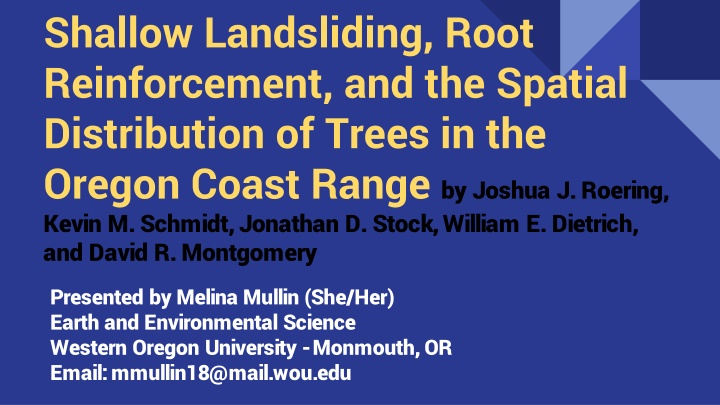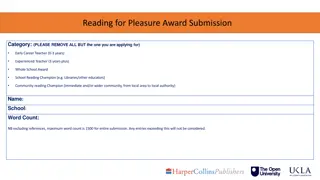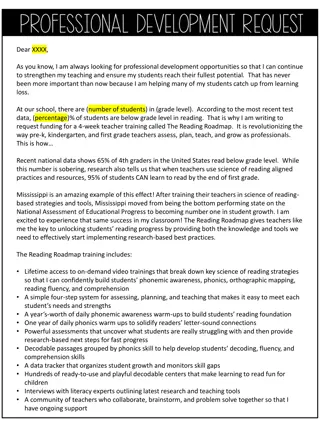
Tree Root Reinforcement Effect on Shallow Landsliding in Oregon Coast Range
Explore how tree roots in the Oregon Coast Range reinforce shallow soils, impacting landslides and slope stability. This study investigates the relationship between root strength, tree distribution, and potential landslide risks in forested mountainous regions.
Download Presentation

Please find below an Image/Link to download the presentation.
The content on the website is provided AS IS for your information and personal use only. It may not be sold, licensed, or shared on other websites without obtaining consent from the author. If you encounter any issues during the download, it is possible that the publisher has removed the file from their server.
You are allowed to download the files provided on this website for personal or commercial use, subject to the condition that they are used lawfully. All files are the property of their respective owners.
The content on the website is provided AS IS for your information and personal use only. It may not be sold, licensed, or shared on other websites without obtaining consent from the author.
E N D
Presentation Transcript
Shallow Landsliding, Root Reinforcement, and the Spatial Distribution of Trees in the Oregon Coast Range by Joshua J. Roering, Kevin M. Schmidt, Jonathan D. Stock, William E. Dietrich, and David R. Montgomery Presented by Melina Mullin (She/Her) Earth and Environmental Science Western Oregon University -Monmouth, OR Email: mmullin18@mail.wou.edu
Overview Introduction Tree Roots Shallow Landslides Slope Stability Model for Shallow Forest Soils Root Networks Study Sites: Oregon Coast Range Tree Mapping and Root Strength Characterization Results and Study Conclusions Summary
A primary erosional process in many soil-mantled, mountainous landscapes Comprised of colluvial sediments, shallow slope failures often initiate in unchanneled valleys or steep slopes Mobilize into debris flows, and then travel long distances through the low-order channel network, scouring and depositing sediment along their paths Introduction Shallow Landsliding
Have the ability to resist tension, thereby increasing the shear strength of shallow soils through mechanical reinforcement In forested mountainous regions, such as the OCR, landslide scarps often reveal broken root tendrils, suggesting that the tensile strength of the roots was mobilized during failure Linking the characteristics and distribution of trees with quantitative estimates of root strength will improve ability to identify potentially unstable areas and evaluate the implications of land management practices. Introduction Tree Roots
Slope Stability Model for Shallow Forest Soils
The CoulombTerzaghi failure criterion predicts slope instability when shear stress (kPa), , equals or exceeds shear strength because of cohesion and frictional resistance Cs + Cr + tan E1 Can be used to assess the stability of shallow soil mantled hillslopes Slope Stability Model for Shallow Forest Soils Equation 1
Absgzsincos Ab(Csb + Crb) + AL(CsL + CrL) + Ab[( s wM)gzcos2 tan ] Simplifies the mechanical complexities introduced by upslope and downslope stresses acting on the slide mass, hence, should be used for comparative estimates of how root reinforcement influences slope stability Slope Stability Model for Shallow Forest Soils Equation 2
In humid, coniferous forests, the lateral extent of tree root networks increases with tree diameter and mirrors the crown coverage The distribution of trees surrounding a potential landslide site controls the apparent cohesion owing to root strength Tree species has an important influence on the temporal and spatial distribution of root strength Root Networks
The depth, density, and size distribution of roots depends strongly on species Analysis focuses on using tree distributions and root network geometry to quantify lateral root strength in the OCR. Mapped trees around shallow landslide scarps and estimated root cohesion by inventorying exposed broken roots. Done In order to explore whether landslides in forested terrain tend to occur in areas with an abundance of coniferous trees Root Networks
February of 1996 high intensity storms triggered thousands of landslides in the OCR The 4-day rainfall total exceeded 700 mm in many areas and the maximum daily total was 208 mm In November 1996, another intense storm produced over 220 mm of rainfall over a 3-day period, triggering widespread slope failures and causing six fatalities Study Sites: OCR
The Oregon Department of Forestry (ODF) conducted a storm impact study in several regions of the OCR to document the character and frequency of landslides in forests with different management histories Their results suggest that in recently (<10 years) clearcut terrain the frequency of landslides because of the 1996 storms exceeds that in 100+ year-old stands. Study Sites: OCR
Soil-mantled hillslopes in parts of the OCR are steep (sometimes exceeding 40 ) and typically exhibit alternating sequences of ridges and unchanneled valleys Visited three forested areas with similar underlying bedrock (greywacke, Tyee Formation) in the central OCR that experienced widespread shallow landsliding because of the 1996 storms (Fig. 1) Study Sites: OCR
Tree Mapping and Root Characterization
Documented the distribution of trees around 32 landslide scarps in the Mapleton and ESF study areas to determine how local tree cover may influence root strength and slope stability Most of the landslides visited had been identified and mapped by Robison et al. (1999), whose protocol entailed walking all channels in the study areas to look for landslides Tree Mapping and Root Characterization
At each site, quantified landslide scarp morphology (including length, width, depth of soil (measured vertically), and slope of the initial failure site) and mapped all trees within 14 m of the landslide scarp (including species, diameter at breast height (dbh), condition (live, dead, or cut), and distance to scarp (measured horizontally) (Fig. 3) Measured tree-to-scarp distances to within 0.1 m and soil and rooting depths to within 0.05 m Tree mapping and Root Characterization
Along with characterizing the surrounding vegetation, those conducting the study quantified root strength for 12 of the landslide scarps (in the Mapleton and ESF study areas) and for four soil pits (in the Silver Creek stand (within ESF) and Hubbard Creek study area)
Results and Study Conclusions
Tree mapping results illustrate how vegetative patterns vary within forested landscapes Aerial photographs suggest that both the Mapleton and ESF study areas are characterized by dense, coniferous stands The character of vegetation proximal to landslide scarps varied significantly, both within and between the two study areas Results and Conclusions
For the 11 shallow landslide sites visited, roughly equal numbers of live hardwood and coniferous trees within 8m of the headscarps were observed (Fig. 5)
Analyses indicate that the spacing, size, and condition of trees control the spatial pattern of root strength and influence the location of shallow landsliding in forests With the proposed model, root tensile strength (and apparent cohesion because of roots) may be estimated from data describing the position, size, species, and condition of trees on soil-mantled hillslopes Results and Conclusions
The variability of tree size, species, and condition (as controlled by land-use practices, fires, tree senescence, climate change, and other factors) is reflected in the subsurface character of root networks Slope stability calculations and field observations suggest that the evolving mosaic of root strength observed in forests has an impact on shallow landsliding Summary
Overall, documented the distribution and characteristics of trees adjacent to 32 shallow landslides that occurred during 1996 in the Oregon Coast Range Observed sparse coniferous and abundant hardwood trees near landslide scars in an industrial forest (Mapleton) Observed similar numbers of live conifer and hardwood trees proximal to landslide scarps Summary What was done?
Demonstrated that root strength quantified in landslide scarps and soil pits correlates with a geometry-based index of root network contribution derived from mapping the size, species, condition, and spacing of local trees Indicates that root strength can be predicted by mapping the distribution and characteristics of trees on potentially unstable slopes Summary What was done?






















